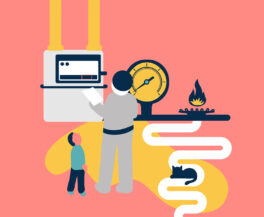Gas must be treated with respect
Gas safety
 Natural gas is a very convenient and clean fuel and its combustion emits only water vapour and a small amount of carbon dioxide. However all use and safety requirements must be carefully met.
Natural gas is a very convenient and clean fuel and its combustion emits only water vapour and a small amount of carbon dioxide. However all use and safety requirements must be carefully met.
Gas boilers and water heaters must be maintained regularly, preferably once a year. Unmaintained equipment can increase energy consumption and accidents. Maintenance care should be performed by a trusted and licensed service provider.
Gas needs oxygen
The gas equipment must be protected from dust and connected to a clean flue that is suitable for natural gas flue gases and must be of an appropriate size. The room in which the gas equipment is located must have sufficient air flow to ensure complete combustion of the natural gas.
The complete burning of one cubic metre of gas requires about 10 cubic metres of air. The supply of fresh air must be provided in small rooms, especially in bathrooms, by using an air grille or an opening under the door.
Causes of gas accidents
- Appliances that have not been maintained, old pipes and negligence.
- Unauthorized repair of ventilation pipes or flue exhaust pipe, or diversion of the gas equipment flue to the wrong pipe.
- Clogged flue exhaust pipe.
- Damaged or rusty pipes and connections.
- Use of materials not suitable for gas in pipe installation.
- Small and unventilated rooms with insufficient air flow for the gas equipment.
- Worn out gas equipment.
Useful to know
- The gas flame must be blue and not yellow (also applies to the hob).
- If the ceiling turns yellowish or brown, there are problems with the chimney.
- If you suspect any faults, a check must always be carried out. This work can only be performed by a company or a person with the appropriate qualifications.
- A carbon monoxide detector must be installed in all living areas where there is gas equipment connected to the chimney.
Carbon monoxide detector
Carbon monoxide is produced by incomplete combustion of the fuel. Carbon monoxide is colourless, odourless, tasteless and very dangerous.
The first signs of carbon monoxide poisoning are headache, dizziness, tiredness and nausea. A person might not associate these symptoms with poisoning and they may be completely imperceptible when sleeping and cause death.
The carbon monoxide sensor signals when the concentration of carbon monoxide in the air is approaching a level that is dangerous to human health.
Carbon monoxide detectors should be installed in all living areas where there is gas equipment, such as gas boiler or water heater connected to the chimney, as well as in rooms with wood-burning stove or fireplace.
Where to install a carbon monoxide detector
Unlike a smoke detector, a carbon monoxide sensor must be installed on the room wall at a height of 0.5 to 1.5 metres from the floor and up to 3 metres from the carbon monoxide source. The sensor must not be placed near ventilation systems. If the gas boiler is in the bathroom, make sure that the carbon monoxide sensor is suitable for installation in wet areas.
In rooms without immediate heating device, the detector should be placed close to the human breathing radius. For example, in the living room, the sensor must be placed at the height of a person’s face, when sitting on a sofa or chair. In bedrooms, the carbon monoxide sensor must be as close to the bed as possible.
One sensor is for one room only, as the device measures the level of carbon monoxide next to the sensor. In multi-storey residential buildings, it is recommended to install a detector on each floor, as well as in each bedroom.

Gas leak
For safety reasons a distinctive aroma is added to natural gas used in homes and offices in order for people to be able to smell a gas leak. Possible gas leaks in underground piping systems are detected with specialized gas measuring instruments.
In the case of a gas leak, you must
- Shut off the gas supply if possible.
- Ventilate the rooms by opening doors and windows.
- Not use naked flames or electricity and, if possible, turn off the electricity supply to the gas leak area.
- Leave the danger area.
